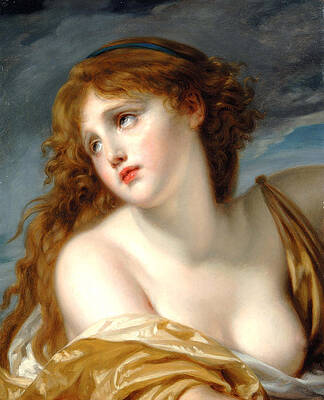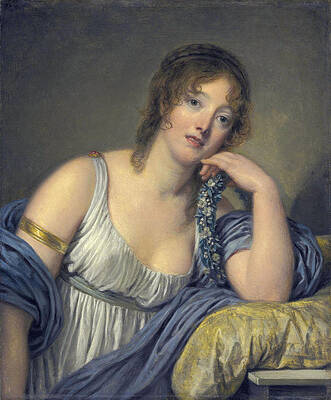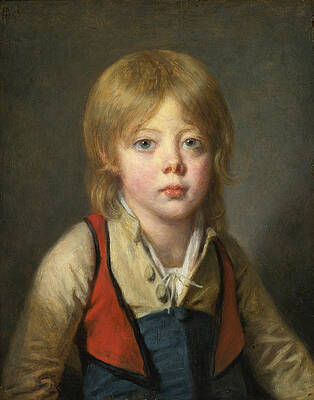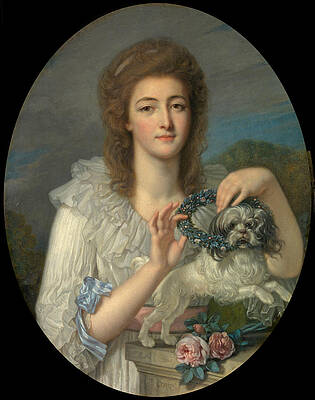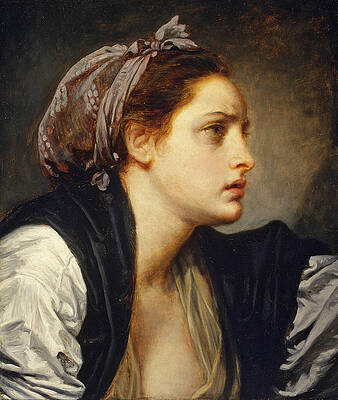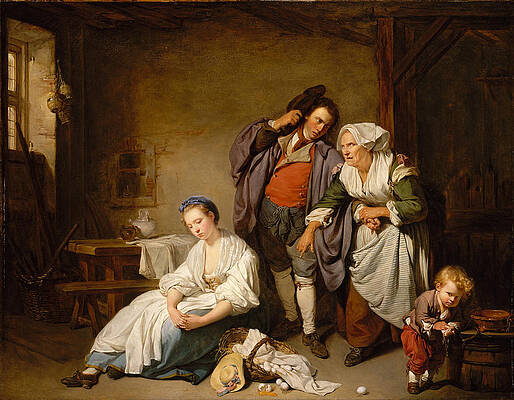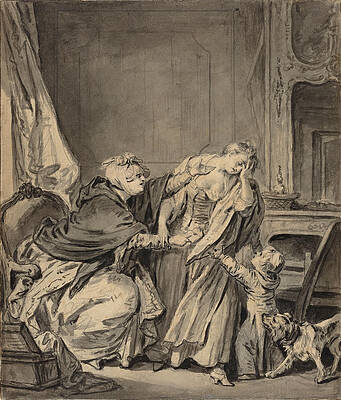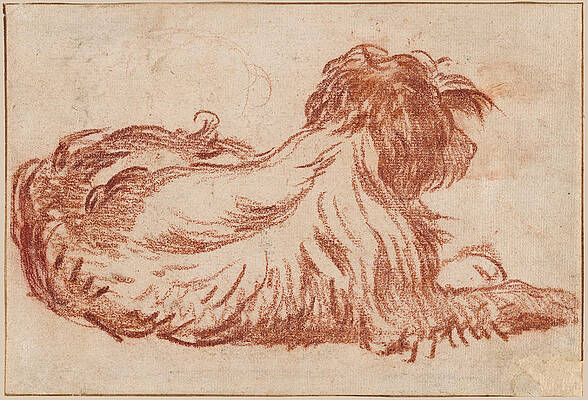Jean-Baptiste Greuze
Paintings
Madame Jean-Baptiste Nicolet
Psyche
A Child with an Apple
Jeanne Philiberte Ledoux
The Nymph Callisto
Charles Claude de Flahaut, Comte d'Angiviller
Young Peasant Boy
A Girl
Princess Varvara Nikolaevna Gagarina
The Laundress
Head of a Young Woman
Study Head of a Woman
Aegina Visited by Jupiter
Broken Eggs
Bust of a Young Woman
The Awakening
Portrait of a Man
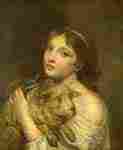
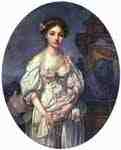
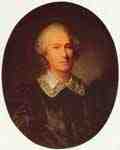
Portrait of Randon de Boisset, Oval

Portrait of a young peasant girl
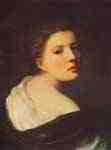
Drawings
Reclining River God
The Angry Mother
The Angry Wife
A Young Girl Looking Upward
A Dog
The Ungrateful Son
The Well-Loved Mother

Half-length portrait of an old man
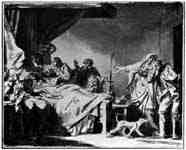

Group of figures with two men who try to bind the hooves of a downed dead
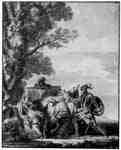
Illustration to "Orlando Furioso"
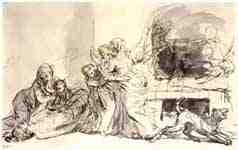

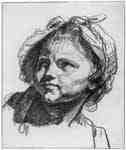
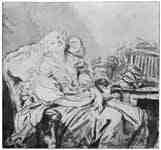
Fine Art Prints | Greeting Cards | Phone Cases | Lifestyle | Face Masks | Men's , Women' Apparel | Home Decor | jigsaw puzzles | Notebooks | Tapestries | ...
Girl with a Dead Canary
Jean-Baptiste Greuze (21 August 1725 – 4 March 1805) was a French painter. He was born at Tournus, Burgundy. He is generally said to have formed his own talent; this is, however, true only in the most limited sense, for at an early age his inclinations, though thwarted by his father, were encouraged by a Lyonnese artist named Grandon, or Grondom, who enjoyed during his lifetime considerable reputation as a portrait-painter. Grandon not only persuaded the father of Greuze to give way to his son's wishes, and permit the lad to accompany him as his pupil to Lyon, but, when at a later date he-himself left Lyon for Paris – where his son-in-law Grétry the celebrated composer enjoyed the height of favour – Grandon carried young Greuze with him.Settled in Paris, Greuze worked from the living model in the school of the Royal Academy, but did not attract the attention of his teachers; and when he produced his first picture, "Le Père de famille expliquant la Bible a ses enfants," considerable doubt was felt and shown as to his share in its production. By other and more remarkable works of the same class Greuze soon established his claims beyond contest, and won for himself the notice and support of the well-known connoisseur La Live de Jully, the brother-in-law of Madame d'Epinay.
In 1755 Greuze exhibited his "Aveugle trompé," upon which, presented by Pigalle the sculptor, he was immediately agréé by the Academy.[1]
The Guitarist (1757), National Museum in Warsaw.
Towards the close of the same year he left France for Italy, in company with the Abbé Louis Gougenot, who had deserted from the magistrature – although he had obtained the post of conseiller au Châtelet in order to take the petit collet. Gougenot had some acquaintance with the arts, and was highly valued by the Academicians, who, during his journey with Greuze, elected him an honorary member of their body on account of his studies in mythology and allegory; his acquirements in these respects are said to have been largely utilized by them, but to Greuze they were of doubtful advantage, and he lost rather than gained by this visit to Italy in Gougenot's company. He had undertaken it probably in order to silence those who taxed him with ignorance of great models of style, but the Italian subjects which formed the entirety of his contributions to the Salon of 1757 showed that he had been put on a false track, and he speedily returned to the source of his first inspiration.[1]
Relations with the Academy
In 1759, 1761 ("L'accordée de village", Louvre), and 1763 Greuze exhibited with ever-increasing success; in 1765 he reached the zenith of his powers and reputation. In that year he was represented with no less than thirteen works, amongst which may be cited "La Jeune Fille qui pleure son oiseau mort", "La Bonne Mère", "Le Mauvais fils puni" (Louvre) and "La Malediction paternelle" (Louvre). The Academy took occasion to press Greuze for his diploma picture, the execution of which had been long delayed, and forbade him to exhibit on their walls until he had complied with their regulations. "J'ai vu la lettre," says Diderot, "qui est un modèle d'honnêteté et d'estime; j'ai vu la réponse de Greuze, qui est un modèle de vanité et d'impertinence: il fallait appuyer cela d'un chef-d'œuvre, et c'est ce que Greuze n'a pas fait." (I have read the letter, which is a model of honesty and reverence; I have seen Greuze's response, which is a model of vanity and impertinence: he should have backed it up with a masterpiece, and that's precisely what he didn't do.)[1]
The White Hat, 1780
Greuze wished to be received as a historical painter, and produced a work which he intended to vindicate his right to despise his qualifications as a peintre de genre. This unfortunate canvas "Sévère et Caracalla" (Louvre) was exhibited in 1769 side by side with Greuze's portrait of "Jeaurat" (Louvre) and his admirable "Petite Fille au chien noir". The Academicians received their new member with all due honours, but at the close of the ceremonies the Director addressed Greuze in these words "Monsieur, l'Académie vous a reçu, mais c'est comme peintre de genre; elle a eu égard à vos anciennes productions, qui sont excellentes, et elle a fermé les yeux sur celle-ci, qui n'est digne ni d'elle ni de vous." (Sir, the Academy has accepted you, but only as peintre de genre; the Academy has respect for your former productions, which are excellent, but she has shut her eyes to this one, which is unworthy, both of her and of you yourself.) Greuze, greatly incensed, quarrelled with his confreres, and ceased to exhibit until, in 1804, the Revolution had thrown open the doors of the Academy to all the world.[1]
Portrait of Benjamin Franklin, 1777
In the following year, on 4 March 1805, he died in the Louvre in great poverty. He had been in receipt of considerable wealth, which he had dissipated by extravagance and bad management (as well as embezzlement by his wife), so that during his closing years he was forced even to solicit commissions which his enfeebled powers no longer enabled him to carry out with success. "At the funeral of the long neglected old man, a young woman deeply veiled and overcome with emotion plainly visible through her veil, laid upon the coffin, just before its removal, a bouquet of immortelles and withdrew to her devotions. Around the stem was a paper inscribed:
These flowers offered by the most grateful of his students are emblems of his glory. It was Mlle Mayer, later the friend of Prudhon.[2]
The brilliant reputation which Greuze acquired seems to have been due, not to his accomplishments as a painter – for his practice is evidently that current in his own day – but to the character of the subjects which he treated. That return to nature which inspired Rousseau's attacks upon an artificial civilization demanded expression in art.[1]
Legacy
Diderot, in Le Fils naturel and Père de famille, tried to turn the vein of domestic drama to account on the stage; that which he tried and failed to do, Greuze, in painting, achieved with extraordinary success, although his works, like the plays of Diderot, were affected by that very artificiality against which they protested. The touch of melodramatic exaggeration, however, which runs through them finds an apology in the firm and brilliant play of line, in the freshness and vigour of the flesh tints, in the enticing softness of expression, by the alluring air of health and youth, by the sensuous attractions, in short, with which Greuze invests his lessons of bourgeois morality. As Diderot said of "La Bonne mère," il a prêché à la population; and a certain piquancy of contrast is the result which never fails to obtain admirers.[1]
"La Jeune Fille à l'agneau" fetched, indeed, at the Pourtal's sale in 1865, no less than 1,000,000 francs. One of Greuze's pupils, Madame Le Doux, imitated with success the manner of her master; his daughter and granddaughter, Madame de Valory, also inherited some traditions of his talent. Madame de Valory published in 1813 a comédie-vaudeville, Greuze, ou l'accorde de village, to which she prefixed a notice of her grandfather's life and works, and the Salons of Diderot also contain, besides many other particulars, the story at full length of Greuze's quarrel with the Academy. Four of the most distinguished engravers of that date, Massard père, Flipart, Gaillard and Levasseur, were specially entrusted by Greuze with the reproduction of his subjects, but there are also excellent prints by other engravers, notably by Cars and Le Bas.[1]
Cultural references
The broken vessel
In the fifth part of Victor Hugo's Les Misérables, book 5, chapter IV, M. Gillenormand, upon first witnessing Cosette, exclaims "How pretty she is! She is a Greuze." [3]
In the second chapter of Arthur Conan Doyle's Sherlock Holmes story The Valley of Fear, Holmes' discussion of his enemy Professor Moriarty involves a Greuze painting, intended to illustrate Moriarty's wealth despite his small income.
Ethel White, author of "The Wheel Spins", 1936, describes the bedroom of the mysteriously disappeared Miss Froy thusly: "It was a typical schoolgirl's bedroom, with primrose walls and sepia photogravures of Greuze's beauties--limpid-eyed and framed in dark stained oak". (Chapter 18.) This novel was adapted and made into the famous Hitchcock film, "The Lady Vanishes" along with two other more recent movie versions of this story.
A 1946[4] episode of the old time radio series The New Adventures of Sherlock Holmes entitled "The Girl With the Gazelle" centers around the theft of a fictional Greuze painting of the same name, masterminded by Professor Moriarty. The episode, written by Denis Green and Antony Boucher,[5] was "suggested by an incident in Sir Arthur Conan Doyle's story, The Final Problem." There is nothing comparable in that story, though a subplot concerning Moriarty's theft of the Mona Lisa would be added to the beginning of an adaptation of "The Final Problem" for the television series The Adventures of Sherlock Holmes in 1985. It was more likely inspired by a reference to Greuze's "La jeune fille à l'agneau," observed on Moriarty's wall during a police interview in The Valley of Fear.
In the sixth part of The Leopard, a novel by the Italian writer Giuseppe Tomasi di Lampedusa, the Prince of Salina watches a Greuze painting, La Mort du Juste, and he starts thinking about death (as the "safety exit" which relieves older men of their anxieties) and judges that the pretty girls surrounding the dying man and the "disorder of their clothes suggested sex more than sorrow ... were the real subject of the picture." The scene ends in the Prince's nephew Tancredi and Tancredi's fiancee Angelica joining him in the library. Tancred asks "Are you courting death?" and Angelica invites the Prince to dance, at once reviving his vital energies.[6]
In Agatha Christie's "The Murder at the Vicarage," Miss Marple mentions her nephew considers another character "the perfect Greuze."
In the sixteenth chapter of E. M. Forster's novel Maurice, Clive mentions that he finds himself unable to approach Greuze's "subject matter" from anything more than purely aesthetic perspective, contrasting Greuze's work with that of the Greek sculptors in the process.
Chinese author Xiao Yi mentions Greuze's work The Broken Pitcher throughout the first half of her novel Blue Nails. The Broken Pitcher is also mentioned in the first scene of the Jean-Paul Sartre play, The Respectful Prostitute.
The alternative rock band Smashing Pumpkins feature an altered version of Greuze's The Souvenir (Fidelity) on the cover of their album Mellon Collie and the Infinite Sadness.
Jean-Baptiste Greuze is referenced in the song "(We All Wear A) Green Carnation", Noël Coward's celebration of camp and queerness, from his 1929 operetta Bitter Sweet:
"We believe in Art, / Though we’re poles apart / From the fools who are thrilled by Greuze. / We like Beardsley and Green Chartreuse. / (...) Faded boys, jaded boys, come what may, / Art is our inspiration / And as we are the reason for the “Nineties” being gay, / We all wear a green carnation."
In Chapter Two of Part Two of "Love in a Cold Climate" by Nancy Mitford, Jassy and Victoria are visiting Fanny in Oxford and Jassy says: "Well, Sadie was telling how some people, before their babies are born, gaze at Greuze so that their babies will look like it ...".
See also
Les Neuf Sœurs
References and sources
References
Chisholm 1911.
Stranahan, C.H., ‘’A History of French Painting: An account of the French Academy of Painting, its salons, schools of instructions and regulations’’, Charles Scribner’s Sons, New York, 1896 p. 118
Hugo, Victor, Les Misérables, trans. by Charles E. Wilbour, Modern Library, New York, date not indicated, p. 1126.
"Episode: "Sherlock Holmes - The Girl With The Gazelle"". Retrieved 13 September 2012.
Greenwald, Ken. "Sherlockian Story Summaries". Retrieved 13 September 2012.
Lampedusa, Guisseppe di, The Leopard, trans. by Archibald Colquhoun. New York: Pantheon Books, 2007, p. 227.
Sources
Normand, J. B. Greuze (1892).
Emma Barker, Greuze and the Painting of Sentiment (Cambridge: Cambridge University Press, 2005). ISBN 0-521-55508-6.
Gillet, Louis (1913). "Jean-Baptiste Greuze". Catholic Encyclopedia. New York: Robert Appleton Company.
This article incorporates text from a publication now in the public domain: Chisholm, Hugh, ed. (1911). "Greuze, Jean Baptiste". Encyclopædia Britannica (11th ed.). Cambridge University Press.
----
Fine Art Prints | Greeting Cards | Phone Cases | Lifestyle | Face Masks | Men's , Women' Apparel | Home Decor | jigsaw puzzles | Notebooks | Tapestries | ...
----
Artist
A - B - C - D - E - F - G - H - I - J - K - L - M -
N - O - P - Q - R - S - T - U - V - W - X - Y - Z
Retrieved from "http://en.wikipedia.org/"
All text is available under the terms of the GNU Free Documentation License




